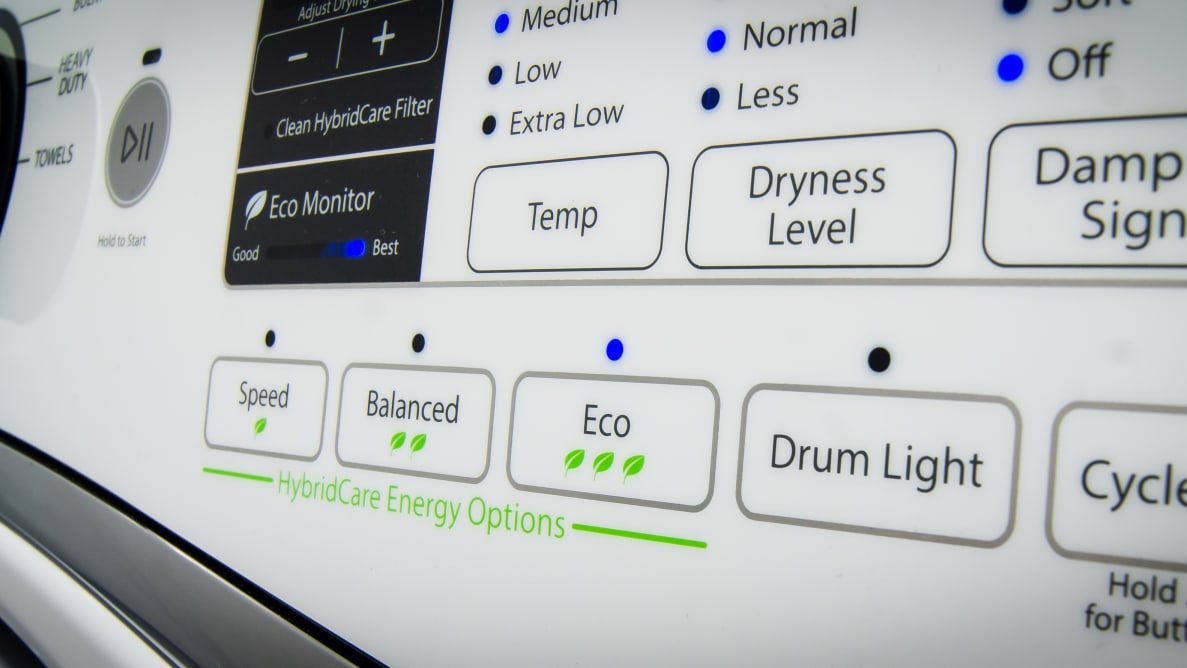Pros
Cons
While it may look like any other high-end dryer, this one hides some unique technology. The 7.4-cubic-foot Whirlpool is the only full-size ventless dryer on the market, and it's the first dryer in America to use an energy-saving heat pump.
Unlike traditional dryers—which pull room-temperature air in, heat it up, and vent it out—a heat pump dryer recirculates hot air while removing moisture from clothes. It's a novel design that can cut the cost of drying clothes by as much as 50 percent. Because heat pump dryers don't get very hot, it means you can also use it for delicate garments that you might not normally machine dry. It also means you'll save your clothes from premature wear regardless of fabric type.
We were curious to see how the new technology performed, so we put the WED99HEDW through our tests. We're holding off on scoring it for now, until we can compare it to the new LG model that's due in stores later this year.
Still, we can confidently say that this new technology is worth checking out. The most efficient settings and cycles may run a bit longer than you're used to, but the WED99HEDW's energy savings are unmistakable. Its ventless design also opens it up to consumers who might not have been able to consider installing a dryer in their home. True, this Whirlpool is definitely more expensive than comparable traditional dryers in terms of style and feature selection, but the manufacturer expects utility companies to offer significant rebates in the near future.
For now, early adopters and green living aficionados should take note. If you've got solar panels on your roof and a Tesla in the garage, you should probably have a WED99HEDW in your laundry room.
{{brightcove '3849643779001'}}
Design & Usability
Everything you know and love... plus a few extras
The Whirlpool heat pump hybrid looks and feels like any other regular electric dryer. In fact, it’s very much akin to the Whirlpool Duet WED97HEDBD… minus the Black Diamond finish, of course.
It’s a typical white dryer with reflective metal trim on the door and underneath the control panel. The easy-to-read touch controls, with the digital countdown timer and bright blue indicator lights, are just what you’d expect from a modern mid-range or high-end dryer. It does still require a 220 volt plug, though. Keep in mind that, with its 7.3-cubic-foot capacity, this is the only full-size ventless dryer on the market. Any other ventless dryer you've seen is likely a 24-inch, European-style condenser model.
Comfortable familiarity aside, you might notice some unusual differences in the back: Namely, the lack of a vent and the inclusion of a hose. Since you don’t need to vent the heat pump dryer outside, you can put it as close to a wall as the l-curve in the hose will allow. The hose, which is used to drain the water that comes out of your clothes, can simply hook into whatever drainage pipe you already have installed for your washer.

The primary lint trap pops forward for cleaning. It's meant to make for easier lint removal—just flip it open over the trash—but we didn't find that it improved on the single screen design all that much.
There’s also a secondary lint trap built into the front of the dryer. Since the Duet recycles air, the double lint trap system is used to catch as many particulates as possible. While you'll want to wipe off the regular lint trap after each cycle, you’ll only need to clean the secondary screen every five cycles or so. Incase you forget, an indicator light on the control panel will let you know when it needs attending to.
{{ photo_gallery name="Lint Trap" }}
Using the Dryer
As fast as you want it to be
Unlike the heat pump dryers that are popular in Europe, which don't use any external heating elements, Whirlpool included a 1300W heating element in the WED99HEDW to keep drying time as close to what you'd be used to as possible.
In total, there are three different settings available to use that offer different efficiency levels. Each uses a different combination of the machine's heat pump and heating element.
Speed mode causes the dryer to behave more or less like a conventional model. Cycles take about as long as users might be used to, and energy savings—while still present—aren't as significant as they could be.
Eco mode keeps temperatures low and energy savings high, but also extends cycle length. That said, the new cycle times are surprisingly reasonable: On Eco, the Normal cycle only took an hour and 28 minutes, while Casual took just an hour and 9 minutes. The longest Eco cycle we tested was Delicates, which ran for an hour and 46. Compared to many 24-inch condenser dryers—which can run for over two hours on a single Normal cycle—that’s actually not that bad.
Balanced is exactly what it sounds like: a blending of Speed and Eco, for consumers who want clothes sooner but not so quickly that they’re willing to sacrifice all of the energy savings.
Manual cycles, like Timed Dry and Quick Dry, default to Speed, while all other sensor-based cycles default to Eco. Keep in mind, though, that all three energy settings are available on every cycle, placing the choice of what to use entirely in the hands of consumers.
{{ photo_gallery name="Fan & Hose" }}
Performance & Features
Dry clothes, every time.
Every single cycle we tested with standard loads of laundry performed perfectly. Each time, our test loads came out between 99% to 96% dry, whether on Normal, Casual, Delicates, or even Quick. A little leftover dampness is actually ideal, as it cuts down on wrinkles and reduces the risk of damaging clothes by overdrying.

The available cycle options aren't all that extensive, but still cover all the basics.
In terms of bells and whistles, the WED99HEDW is on par with a traditional mid-range dryer—surprising for such an expensive machine. Three dryness levels and four temperature settings—an air dry only option is, of course, absent—actually means less customization than other dryers in this price range. There are no overly fancy features like steam, either. All you get is a control lock, a wrinkle shield, and a damp dry signal with two volume levels.
For in-depth performance information, please visit the Science Page.
Pros & Cons of a Heat Pump
Direct and indirect energy savings galore
The most obvious perk behind a heat pump dryer is reduced energy consumption. Compared to a traditional dryer, a cycle with the heat pump model could use anywhere from 25-50 percent less energy, depending on what you're drying and which cycle you’re using. Whirlpool says the most efficient cycle is Casual in Eco mode, which took an hour and nine minutes to get our test load 96 percent dry at just 117ºF.
You get indirect energy savings, too. Conventional dryers suck air out of your laundry room, heat it, and then pump the used air outside. If you live somewhere with extreme weather, whether it's Duluth or Death Valley, you're pumping heated or air conditioned air outside whenever you do laundry.
Since the heat pump dryer only uses a little bit of external air for an entire cycle, heaters and air conditioners won’t have to work as hard to make up for all the climate-controlled air that's sucked outside, further reducing your seasonal electric bill.
A heat pump dryer is better for your clothes, too. Consistently lower temperatures on the Balanced and Eco settings mean you’ll be able to dry more delicate items like dresses or blouses without having to worry as much about fabric wear or shrinkage.
The only downside we can see at the moment is the price. On sale for $1,525, the WED99HEDW costs almost double what you’d pay for a low- to mid-range conventional dryer. Whirlpool is working with utilities to offer rebates for early adopters, however, which should bring down the price considerably.
Revolutionary Technology
It's easy being green
If you're an early adopter with an eye for green tech, a condo-dweller with a need for a full-size ventless dryer, or a builder of zero net-energy buildings, the Whirlpool Duet WED99HEDW heat pump dryer is just what you're looking for.
At the end of the day, we simply couldn’t find any major drawbacks in terms of performance, design, or functionality. True, the feature list and level of customization could use some beefing up, but that will undoubtedly come with time.
Even if you aren't planning on buying one, the WED99HEDW is worth keeping an eye on. It's the first wave of a laundry efficiency revolution. This might be the first heat pump dryer to hit the market in the U.S., but it's unlikely to be the last.
By the Numbers
The heat pump system in the new Whirlpool Duet WED99HEDW (MSRP $1699) does slightly extend drying time, but operates at a cooler temperature. That's good news for your delicate clothes.
Normal
We tested the Normal cycle on all three HybridCare energy settings, and each time our test loads came out 98% dry. Normally we’d like to see 99% excess moisture removal, but 98% is close enough to be usable, and besides—a little extra moisture left behind can be good for clothes, whether you want to iron them or put them on a hanger.
Temperatures on the Speed, Balanced, and Eco settings peaked at just 135.4°F (one hour and 9 minutes), 127.7°F (one hour and 18 minutes), and 118.8°F (one hour and 28 minutes), respectively.

The available cycle options aren't all that extensive, but still cover all the basics.
Casual & Delicate
A sticker on the inside of the dryer door states that Casual on Eco is the most energy efficient cycle on the entire machine. While energy consumption varies based on load, we can tell you that this cycle got our 8 lb. load 96% evenly dry after one hour and 9 minutes. Temperatures peaked at a mere 117.5°F, making it a cool and gentle cycle that sets clothes up perfectly to finish drying on a hanger.
Delicates on Eco also did quite well, but it was also the cycle that took the longest. After one hour and 46 minutes, our laundry came out 96% dry. Temperatures peaked at 126.3°F, which was surprising given that Casual and Normal were all cooler. That said, temperatures only stayed that warm for a brief time.

The controls are easy to use, but the customizable options and extra features are actually a bit slim for a dryer this pricey.
Quick Dry & Bulky
The manual Quick Dry defaulted to the Speed setting and 45 minutes long—which somewhat stretches the definition of “quick” in our books. Nevertheless, with temperatures peaking at 127.5°F, our test load came out 100% dry, making this the WED99HEDW's alternative for small batches of clothing.
Heat pumps aren’t magic bullets, unfortunately. Like most dryers, this Whirlpool had trouble with our Bulky test. After one hour and 32 minutes (on Eco) and with temperatures peaking at 122.8°F, our large comforter was only 72% dry.
Meet the tester
Matthew is a native of Brockton, MA and a graduate of Northeastern, where he earned a degree in English and Theatre. He has also studied at the Gaiety School of Acting in Dublin and spends most of his free time pursuing a performance career in the greater Boston area.
Checking our work.
Our team is here to help you buy the best stuff and love what you own. Our writers, editors, and experts obsess over the products we cover to make sure you're confident and satisfied. Have a different opinion about something we recommend? Email us and we'll compare notes.
Shoot us an email



